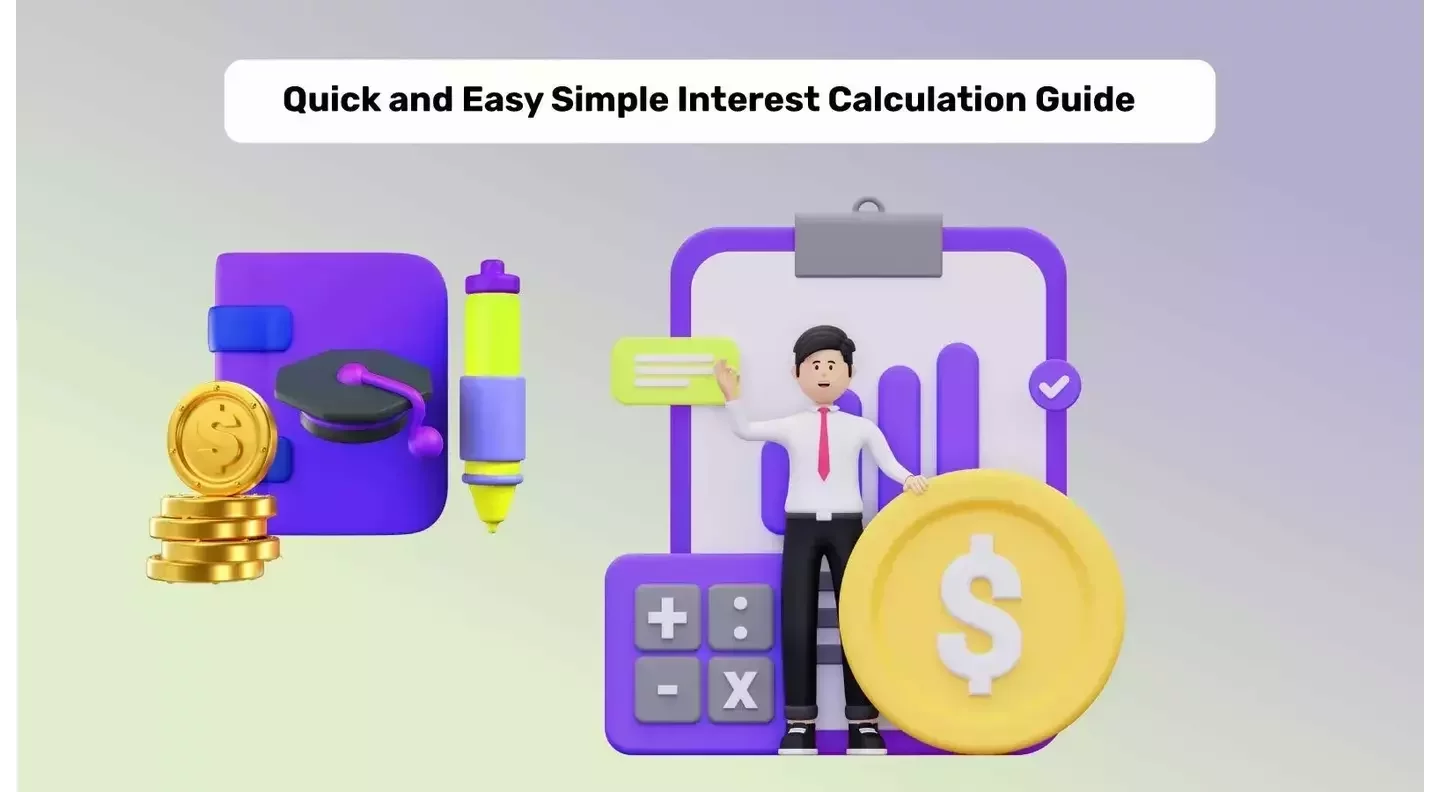Get instant loan offer suitable to your profile !


On this Page:
Confused about simple interest education loans? Our blog explains everything you need to know, from benefits to calculations, making your loan process smoother.
Choosing the correct education loan is an important choice for students studying abroad, but many find themselves negotiating dense financial jargon without fully comprehending the repercussions. This blog tries to fill a knowledge gap by explaining the idea of simple interest (SI) and comparing it with compound interest. With a better understanding of how simple interest works, students may engage in informed talks with lenders, ensuring they acquire conditions that will not lead to negative financial responsibilities. It will also help you learn how to calculate interest for education loans so that you do not lock in any deal that does not go well with your profile. Understanding basic interest is about more than just math; it's about protecting your financial future with certainty and confidence.

Simple interest on a loan is a financial phrase that refers to a way of determining the interest charge on a loan. The interest is calculated just on the principal amount, or the original money borrowed, without compounding. This means that, regardless of the length of the loan term, the borrower is only charged interest on the amount initially borrowed. This computation approach is especially useful for students studying abroad since it makes the cost of borrowing more predictable and manageable.
Understanding how to calculate education loan interest, including student loan interest each month, is simple. Use this formula to figure out how interest is calculated on education loan:
Interest = Principal x Rate x Time (I = P x R x T), where:



To illustrate the differences between simple and compound interest, consider the following tabular comparison. It will enhance your understanding of how education loan interest is calculated.
| Basis of Difference | Simple Interest | Compound Interest |
|---|---|---|
|
Calculation basis |
Calculated on the principal amount only. |
Calculated on the principal and the accumulated interest. |
|
Interest accumulation |
Does not accumulate interest on top of interest. |
Accumulates interest on the principal plus any accrued interest. |
|
Cost over time |
Generally results in a lower total cost of the loan. |
Can significantly increase the total repayment amount due to interest compounding. |

Understanding how to compute simple interest on an educational loan is critical for financial planning. Here is a quick breakdown of the simple interest EMI formula.



GyanDhan's Education Loan EMI Calculator is a useful tool for students and families to accurately assess the financial consequences of taking out an education loan to study abroad. This application streamlines the difficult loan calculating procedure, making it more accessible and user-friendly.
Simply enter the education loan amount (Principal), interest rate, and loan tenure (number of months) into the education loan EMI calculator, and it will instantly compute the education loan EMI using the mathematical equation:
|
EMI = [P x R x (1 + R)n] / [(1 + R)n - 1] where P = Principal, R = Rate of Interest, and n = Tenure/duration in number of months |

When considering education loans for studying abroad, it's vital to compare the interest rates offered by different lenders. The table below will help you explore interest rates offered by different lenders.
| Lender Name | Secured Loan Interest Rate | Unsecured Loan Interest Rate |
|---|---|---|
|
9.65-10.15 |
9.65-10.15 |
|
|
9% - 11.5% |
9.5% |
|
|
10.90% |
11.5%-12.5% |
|
|
10.50% |
11.25%-12.50% |
|
|
11% |
10.75%-12.25% |
|
|
10.50% |
11.5%-12.5% |
|
|
11.00% |
11.75-13% |
|
|
10.5% - 11% |
11.5-12.5 |
|
|
10.50% - 11% |
12.25-12.75% |
|
|
NA |
12-14% USD |
|
|
10.25% |
11.25%-11.75% |
|
|
NA |
12.74% USD |
|
|
9.65% - 10.15% |
NA |
|
|
9.7% - 10.50% |
NA |

Simple interest on school loans is extremely useful to students because of its simple calculating mechanism, which adds interest charges directly to the principal amount borrowed. This transparency provides numerous major benefits, including improved financial predictability and management over the terms of the loan.



Did you know? You can save BIG with smart repayment strategies. We have listed them down for you here.

Paying simple interest on education loan during a moratorium, including understanding how to calculate student loan interest per month, significantly impacts the overall cost. For a loan of INR 5,00,000 with a 10% annual interest rate and a 12-month moratorium, paying the simple interest monthly, approximately INR 4,167 (INR 5,00,000 x 10% ÷ 12), prevents interest from adding to the principal during this period. Now you know how is student loan interest calculated, it will help you make more informed decisions.
This strategy not only prevents the loan balance from rising, but also assures that the total interest paid during the loan's term is significantly lower. For example, if the interest is not paid during the moratorium, the total payable amount at the conclusion of the loan period may be much greater owing to interest compounding on the increased principal. Paying interest during the moratorium results in long-term savings and lessens the financial burden after the study period.

Effectively managing simple interest on education loan can greatly impact the overall cost and duration of your loan. Here are detailed strategies:




To calculate simple interest on education loans, multiply the principal amount by the interest rate and then by the time in years. This calculation method ensures borrowers pay interest only on the original loan amount, not on accumulated interest, making it a cost-effective option for managing education-related expenses.
Education loan interest is usually linked to the repo rate set by the RBI. Banks add a spread over this rate, based on factors like loan amount, collateral, course, and university. The final interest rate is generally repo rate plus spread, where the spread varies by lender and applicant profile.
Yes, education loans from Indian lenders are usually compounding in nature, meaning that interest is calculated on the principal amount as well as on the accumulated interest over time. In case you pay simple interest during moratorium then it is not compounding in nature. This compounding effect can vary in frequency depending on the lender's policy, often calculated annually or quarterly.
Factors affecting what is simple interest on education loans include the borrower's credit score, the loan amount, the repayment term, and whether the loan is secured or unsecured. Understanding these factors can help borrowers secure the best possible rate for their education financing needs.
Private lenders may have specific policies that influence how to calculate interest for education loan, such as requiring interest payments during study periods to avoid compounding. Borrowers should review these policies carefully to understand the true cost of their loan and avoid potential misunderstandings. You can read more about it here.
Understanding how to calculate simple interest on education loans can significantly aid in long-term financial planning by providing clear insights into the total cost of borrowing for education. This knowledge helps borrowers make informed decisions, potentially saving thousands in interest payments over the life of the loan.
Check Your Education Loan Eligibility

Ask from a community of 10K+ peers, alumni and experts
Trending Blogs
Similar Blogs

Network with a community of curious students, just like you
Join our community to make connections, find answers and future roommates.. Join our CommunityCountry-Wise Loans
Best Lenders for Education Loan

ICICI Bank

Axis Bank

Union Bank

Prodigy

Auxilo

Credila

IDFC

InCred

MPower

Avanse

SBI

BOB

Poonawalla

Saraswat